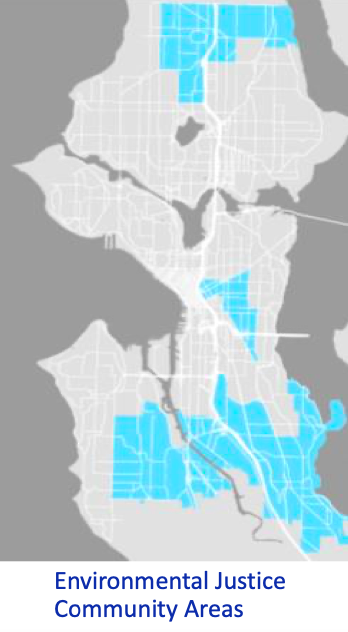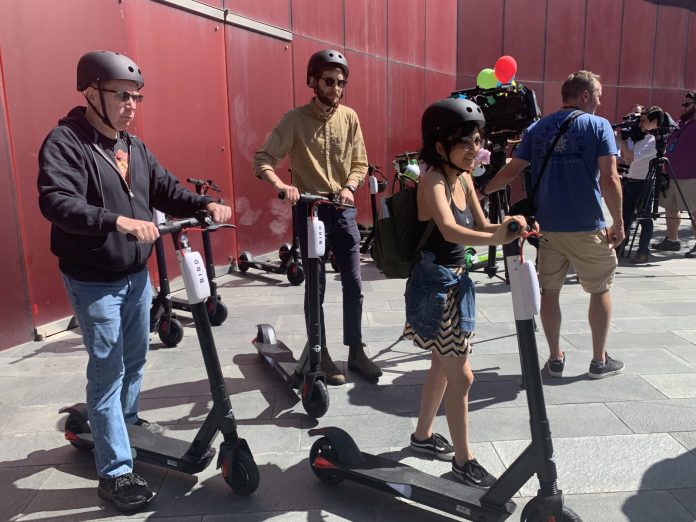Funded by permit fees paid by scooter companies, Seattle’s scootershare pilot will start out with about 1,500 e-scooters this fall.
There is something about dockless e-scooters that feels very pre-Covid. Back when people weren’t worrying constantly over a global pandemic, plenty of people were worried about private companies swarming Seattle with e-scooters that would sooner or later end up jettisoned on our sidewalks.
The potential for head injuries incurred by inexperienced e-scooter riders plummeting down Seattle’s steep hills was also a cause for concern, especially for Mayor Jenny Durkan, who in an op-ed for Wired asked for Seattleites’ patience as the City figured out how it could establish an e-scooter pilot that would promote safety, protect the City’s budget from personal injury lawsuits, focus on equity, and not detract from the Seattle’s then thriving dockless bikeshare scene. This is after the Mayor spread fears of crowded emergency rooms, calling scooters “too dangerous.”
The picture looks very different a year later. Dockless bikeshare disappeared from Seattle’s streets without the arrival of e-scooters, although the acquisition of Uber-owned Jump by bike and e-scooter industry giant Lime has brought some rentable e-bikes back to Seattle, with a promise of more to come. Now in the near future Seattleites can finally expect to see dockless e-scooters as well, and their arrival can be attributed–at least in part–to the Covid epidemic.
According to a recent presentation from the Seattle Department of Transportation (SDOT) for the Seattle City Council Transportation and Utilities Committee, which recently forwarded the pilot on to a full City Council vote September 8th, cities with scootershare have seen their usage rates rise during the epidemic. For example, Portland experienced a 46% increase in e-scooter use, including a doubling of trips in low-income neighborhoods. Additionally, e-scooter travel patterns have also changed.
“In Portland and Detroit, people are traveling 2 to 2.5 miles on an average trip,” said Joel Miller, Micromobility Program Manager at SDOT. “That’s telling us that during this time when people are reluctant to get into transit, carshare, or a [ridehailing vehicle], they’re using scooters to get from where they are to their destination as a real transportation option for essential trips.”
SDOT’s hope is that dockless scootershare will offer Seattleites another option for transportation needs, and that the lesson learned from from previous bikeshare pilots and data collected from other cities will help the agency set up Seattle’s scootershare program for success, although some critics, including Erica C. Barnett of the C is for Crank remain unconvinced.

Key Facts to Know About Seattle’s Dockless E-Scooter Pilot
Here’s a breakdown of some crucial facts about Seattle’s dockless e-scooter pilot. It’s important to note that Seattleites can likely expect the pilot to include some changes as it unfolds. “We know this is an ever-shifting industry and we know we will need to stay nimble and adapt over time,” said SDOT Director Sam Zimbabwe, referencing how both bikeshare and carshare have gone through significant changes over a relatively short timeframe.

- The e-scooter pilot will start small and (potentially) ramp up. At the outset, only 1,500 e-scooters will be permitted; however, that number has the potential to increase to up to 6,000 vehicles if things go well during the pilot.
- Both standing and seated e-scooters will be available to use. Traditional standing e-scooters will be available to rent through Lime and potentially Bird, but Seattle will be the first US city to offer seated e-scooters through Tesla-owned Wheels. “We’re really excited about what [seated e-scooters] may offer Seattle. They tend to have larger wheels, a lower center of gravity, and further back center of gravity, which might be better suited to our pavement conditions, weather, and hills,” said Miller, who also added the seated e-scooters might be “a more useful device for people with disabilities.” Seattleites may also expect to see new “mixed” e-scooters in the future, although design prototypes have not yet been shared with the public.
- Riders will be prohibited from using sidewalks. In the current legislation, e-scooter riders will need to stick to bike lanes and avoid sidewalks, other than in limited areas like the Fremont Bridge, where traffic uses merge. Councilmember Tammy Morales (District 2) voiced fears over rider safety in areas like Southeast Seattle, which have been underserved in bike facility infrastructure and contain dangerous busy streets like Rainier Avenue. (She still voted for the pilot.)
- Permit fees will cover the cost of pilot and pay for other improvements and services. Companies will need to pay $150 permit fee per vehicle. The cost will cover all of the pilots expenses and also fund the creation of additional parking corrals for dockless bikes and e-scooters. It will also continue to fund a City program that provides adaptive bike rentals to people with disabilities through nonprofit Outdoors for All.
- Rider safety continues to be a concern for the City. SDOT will continue to monitor data on safety in partnership with the University of Washington. Additionally, riders will continue to be required to wear helmets while riding and companies will be incentivizing helmet use by distributing helmets in low-income communities, and Wheels has even designed reusable helmets with biodegradable helmet liners for riders to use. Finally, during riders’ first e-scooter share rental, speed limits will max out at 8 mph to give people opportunity to learn how to safely use the vehicle. In general, speed limits will be capped at 15 mph.

The City is also hoping that increased use of e-scooters will help West Seattle meet some of its mobility goals by increasing access to the Alki Water Taxi and other transit hubs. The agency expressed hope that e-scooters could nudge the current 1% of bike trips that leave the West Seattle peninsula up to its stated goal of 10%.
While Transportation Chair Alex Pedersen opposed the pilot program, the other three transportation committee members present voted in favor. Councilmember Lisa Herbold–was absent for the vote because she left early to attend a West Seattle Bridge meeting–did express some concerns about whether this truly was a pilot program or basically just a full launch. People interested in scootershare should contact their councilmembers ahead of the September 8th vote if they’d like to weigh in.
Natalie Bicknell Argerious (she/her) is a reporter and podcast host at The Urbanist. She previously served as managing editor. A passionate urban explorer since childhood, she loves learning how to make cities more inclusive, vibrant, and environmentally resilient. You can often find her wandering around Seattle's Central District and Capitol Hill with her dogs and cat. Email her at natalie [at] theurbanist [dot] org.


